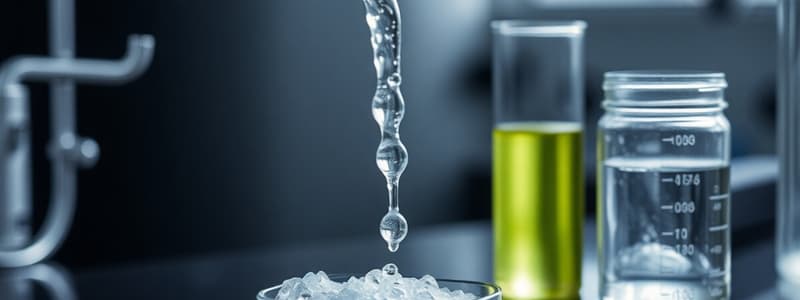Podcast
Questions and Answers
What is the purpose of digestion in the precipitation process?
What is the purpose of digestion in the precipitation process?
What is a primary characteristic of filtration when dealing with colloidal precipitates?
What is a primary characteristic of filtration when dealing with colloidal precipitates?
Which property should washing liquids have to effectively wash precipitate?
Which property should washing liquids have to effectively wash precipitate?
What role do electrolytes play during the coagulation of colloidal precipitates?
What role do electrolytes play during the coagulation of colloidal precipitates?
Signup and view all the answers
Which step follows after precipitation in the series of practical steps?
Which step follows after precipitation in the series of practical steps?
Signup and view all the answers
What happens to small nuclei during the digestion process?
What happens to small nuclei during the digestion process?
Signup and view all the answers
In washing, what is peptization?
In washing, what is peptization?
Signup and view all the answers
Why is it important to choose the correct washing liquid for precipitates like AgCl?
Why is it important to choose the correct washing liquid for precipitates like AgCl?
Signup and view all the answers
Study Notes
Practical Steps for Preparing a Precipitate
- Precipitation: The initial step where a solid (precipitate) forms from a solution.
- Digestion: Allowing the precipitate to stand in the presence of the solution (mother liquor) to allow particles to clump together (coagulate) and improve crystal structure. Small nuclei dissolve, large ones grow larger.
- Filtration: Separating the precipitate from the liquid (mother liquor) using a filter. The precipitate goes onto a filter.
- Washing: Removing surface contaminants and unwanted particles from the precipitate. Properties of the washing liquid are crucial; it shouldn't dissolve the precipitate or cause further precipitation. The liquid should not introduce new impurities
-
Drying or Ignition: Removing water and other volatile impurities from the precipitate.
- Drying: Heating the precipitate below 250°C, often doesn't change the chemical structure.
- Ignition: Heating the precipitate above 250°C, usually leads to a chemical structure change.
- Weighing: Measuring the mass of the dried or ignited precipitate.
Digestion
- Digestion involves standing a precipitate (ppt) in the presence of the original solution (mother liquor) for a period of time. This promotes coagulation of the particles into larger, denser units.
- During digestion, the particles conglomerate to share a common counter ion layer, allowing coagulation and cementing.
- Small nuclei can dissolve while larger ones grow at the expense of the small ones.
- Digestion enhances the crystal structure by expelling impurities and improving internal perfection.
Filtration
- Filtration separates the precipitate from the liquid.
- Crystalline precipitates are easier to filter than colloidal precipitates.
- Colloidal precipitates have a low filtration rate and may pass through the filter paper, leading to a loss of some precipitate.
Washing
- Washing removes surface-adsorbed contaminants.
- Proper wash liquids are essential to avoid dissolving or peptizing the precipitate (which is the reverse of coagulation).
Properties of Washing Liquids
- The washing liquid should NOT dissolve or hydrolyze the precipitate.
- The washing liquid should NOT cause peptization of the precipitate. Peptization is the opposite of coagulation.
- The washing liquid should NOT cause further precipitation of impurities.
Examples of Washing Liquids
- AgCl precipitate (Volhard's method): Acidulated water with HNO3.
- Calcium oxalate (ppt.): 5% Aqueous ammonia.
Role of Electrolytes During Coagulation of Colloidal Precipitate
- Electrolytes cause the counter-ions to be forced closer to the primary layer.
- The counter layer neutralizes the primary layer of the particles and gives neutral coagulated particles.
- Increased concentration of counter-ions shrinks the counter-ion layer, allowing particles to approach more closely to agglomerate.
Peptization
- Colloidal precipitates tend to peptize if washed with pure water because water will dilute and remove electrolytes.
- Peptization is the opposite of coagulation.
- Colloidal solutions peptize when washed with fresh water, and electrolytes need to be present in the washing liquid to prevent this. Add electrolytes to the washing liquid.
Drying and Ignition
- Drying: Heating the precipitate below 250°C (e.g., AgCl) does not change the precipitate's chemical structure but removes water and other volatile impurities.
- Ignition: Heating the precipitate above 250°C (e.g., CaC2O4.H2O) often leads to a change in chemical structure as water and other volatile impurities are expelled.
Pyrolysis Curve
- A graph that shows the weight (on Y-axis) of a precipitate (ppt) versus temperature (on X-axis). A pyrolysis curve is used to determine the weight loss of a sample at various temperature points.
- Shows the stages of dehydration and/or decomposition of a compound.
Studying That Suits You
Use AI to generate personalized quizzes and flashcards to suit your learning preferences.
Related Documents
Description
Test your knowledge on the practical steps involved in preparing a precipitate in chemistry. This quiz covers key concepts such as precipitation, digestion, filtration, washing, and drying techniques. Challenge yourself to understand the significance of each step in producing quality precipitates.




